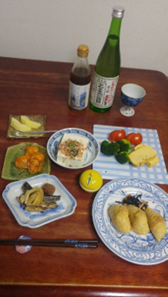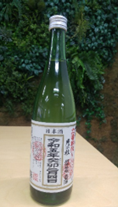Hatsuuma, Inari sushi
Yoshie Doi
 |
 |
Inari sushi and freshly squeezed Japanese sake
In 1750, the word “makizushi” (makisu) was written for the first time in “Ryori Sankaigo”. It is similar to today’s sushi rolls: “Asakusa seaweed, pufferfish skin, or a net is spread on a blind, rice is placed on top, fish are arranged, and the sushi is rolled together.” Rolled sushi was born around 1750-1776 in the mid-Edo period, and it is believed to have become popular around 1783.
In the Edo area, sushi restaurants shifted from selling while walking (furiuri) to street food stalls. It was like fast food. And even if it was sold at a store, it was differentiated from the store by setting up a stall next to the store.
At the end of the Meiji period, ice refrigerators became popular, keeping fish fresh, and even shops that used to have food stalls incorporated food stalls into their stores. That is said to be the origin of the current counter seats.
When my daughter was studying in England, there was a time when she worked part-time at a sushi restaurant. When she took the order, she asked “brown or white”, that is, when ordering brown rice sushi or white rice sushi. There is a Japan center in London, and there is an image of placing anything on top of rice, such as tempura rice bowls. Anyway, Japanese food seems to be accepted. Even if sushi is accepted all over the world, it seems that it is arranged in each country. In Korea, it is established as gimbap with sesame oil instead of sushi rice.
This year, Hatsuuma falls on February 5th, and it is said that we eat Inari sushi on Hatsuuma. Therefore, I heard from the owner of a long-established restaurant that there was a person who brought a plate to the sushi restaurant and bought two pieces of Inari sushi. From 20 to 30 years ago, the catchphrase “Inari-zushi” was used to advertise that people eat it on New Year’s Day, rather than offering it as an offering.
At a sake brewery in Kyoto, you can squeeze the lucky sake of February 4th on the first day of spring and buy it the next day. Every year, I drink a reserved ultimate freshly squeezed rice wine and drink it on dinner on February 5th. I eat sardines 365 days a year, so I don’t have to go out of my way to eat sardines on Setsubun, but I eat them especially on that day as a lucky charm for the first day of spring. I cook twice a week with two days. Sardines accompany my menu every day.
The end of document
